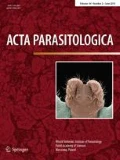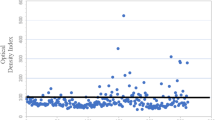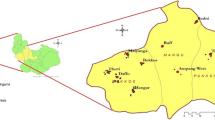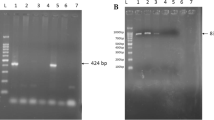Abstract
Purpose
Ehrlichiosis is one of the tick-borne diseases, which is not only neglected in Pakistan but only a few reports have been documented throughout the globe. The purpose of this study is to highlight and report the neglected pathogen from bovines in Pakistan.
Methods
In this study, the pathogen was detected initially based on microscopy, followed by the molecular confirmation and phylogenetic analysis of the pathogen from bovines from south Punjab, Pakistan. The hematological parameters were also assessed in Ehrlichia positive and negative animals. The information of different disease determinants was analyzed by a logistic regression model on SPSS.
Results
The study has reported an 11.98% (23/192) prevalence of Ehrlichiosis from bovines. The prevalence was slightly more in cattle (13.5%) as compared to the buffaloes (10.4%). The previous tick’s history and tick control methods were proved to be the key factors with the occurrence of the disease. The isolates from Pakistan Ehrlichia spp. Pakistan/31, 36, and 8 clustered with the isolates from the USA, Nicaraguan, France, South Africa, and Uganda. Platelet count, hemoglobin level, and hematocrit were found significantly decreased in Ehrlichia affected animals when compared to the healthy bovines.
Conclusion
This is the first report of ehrlichiosis from bovines in Pakistan and will provide the roadmap for future research


Similar content being viewed by others
References
Achenef M, Basaznew B, Mersha C, Wassie M, Gizat A (2014) A three year follow-up study on the occurrence of bovine ehrlichiosis (cowdriosis) at Gondar University dairy farm. J Vet Med Anim Health 6:83–90. https://doi.org/10.5897/jvmah2013.0258
Loftis AD, Mixson TR, Stromdahl EY, Yabsley MJ, Garrison LE, Williamson PC, Fitak RR, Fuerst PA, Kelly DJ, Blount KW (2008) Geographic distribution and genetic diversity of the Ehrlichia sp. from Panola Mountain in Amblyomma americanum. BMC Infect Dis 8:1–7. https://doi.org/10.1186/1471-2334-8-54
Loftis AD, Kelly PJ, Paddock CD, Blount K, Johnson JW, Gleim ER, Yabsley MJ, Levin ML (2016) Panola mozuntain Ehrlichia in Amblyomma maculatum from the United States and Amblyomma variegatum (Acari: Ixodidae) from the Caribbean and Africa. J Med Entomol 53(3):696–698
Kasari A, Miller TR, James RS, Freier AMJE (2010) Recognition of the threat of Ehrlichia ruminantium infection in domestic and wild ruminants in the continental United States. J Am Vet Med Assoc 237:520–530
Walker JB, Olwage A (1987) The tick vectors of Cowdria ruminantium (Ixodoidea, Ixodidae, genus Amblyomma) and their distribution. Onderstepoort J Vet Res 54:353–379
Dantas-Torres F, Chomel BB, Otranto D (2012) Ticks and tick-borne diseases: a one health perspective. Trends Parasitol 28:437–446. https://doi.org/10.1016/j.pt.2012.07.003
Reeves WK, Loftis AD, Nicholson WL, Czarkowski AG (2008) The first report of human illness associated with the Panola Mountain Ehrlichia species: a case report. J Med Case Rep 2:1–3. https://doi.org/10.1186/1752-1947-2-139
Allsopp BA (2010) Natural history of Ehrlichia ruminantium. Vet Parasitol 167:123–135. https://doi.org/10.1016/j.vetpar.2009.09.014
Dahmani M, Davoust B, Benterki MS, Fenollar F, Raoult D, Mediannikov O (2015) Development of a new PCR-based assay to detect Anaplasmataceae and the first report of Anaplasma phagocytophilum and Anaplasma platys in cattle from Algeria. Comp Immunol Microbiol Infect Dis 39:39–45. https://doi.org/10.1016/j.cimid.2015.02.002
Provost A (1987) The historical background and global importance of heartwater. Onderstepoort J Vet Res 54:165–169
Ahmed A, Ijaz M, Ghauri HN, Aziz MU, Ghaffar A, Naveed M, Javed MU (2020) Molecular evidence of Anaplasma infection in naturally affected domestic cats of Pakistan. Comp Immunol Microbiol Infect Dis 72:101524. https://doi.org/10.1016/j.cimid.2020.101524
Ghaffar A, Ijaz M, Ali A, Farooqi SH, Rehman A, Ali MM, Zafar MZ, Naeem MA (2020) First report on molecular characterization of Anaplasmosis in small ruminants in Pakistan. J Parasitol 106:360–368. https://doi.org/10.1645/19-90
Qurollo BA, Riggins D, Comyn A, Zewde MT, Breitschwerdt EB (2014) Development and validation of a sensitive and specific sodB-based quantitative PCR assay for molecular detection of Ehrlichia species. J Clin Microbiol 52:4030–4032. https://doi.org/10.1128/JCM.02340-14
Štefko B, Kiráľová R, Mudrík M (2015) M, Strategic marketing communication in pilgrimage tourism. Procedia Soc Behav Sci 175:423–430
Rehman A, Conraths FJ, Sauter-Louis C, Krücken J, Nijhof AM (2019) Epidemiology of tick-borne pathogens in the semi-arid and the arid agro-ecological zones of Punjab province, Pakistan. Transbound Emerg Dis 66:526–536. https://doi.org/10.1111/tbed.13059
Abbas G (2015) Lahore canine fever in a racing greyhound. Adv Anim Vet Sci 3(6):332–333
Farooqi SH, Ijaz M, Rashid MI, Aqib AI, Ahmad Z, Saleem MH, Hussain K, Islam S, Naeem H, Khan A (2017) Molecular epidemiology of Babesia bovis in bovine of Khyber Pakhtunkhwa, Pakistan. Pak Vet J 37:275–280
Farooqi SH, Ijaz M, Saleem MH, Rashid MI, Ahmad SS, Islam S, Aqib AI, Khan A, Hussain K, Khan NU (2017) Prevalence and molecular diagnosis of Theileria annulata in bovine from three distincts zones of Khyber Pakhtunkhwa province, Pakistan. J Anim Plant Sci 27:1836–1841
Farooqi SH, Ijaz M, Rashid MI, Nabi H, Islam S, Aqib AI, Hussain K, Khan A, Rizvi SNB, Mahmood S, Mehmood K, Zhang H (2018) Molecular epidemiology of bovine anaplasmosis in Khyber Pakhtunkhwa, Pakistan. Trop Anim Health Prod 50:1591–1598. https://doi.org/10.1007/s11250-018-1599-2
Baticados A (2010) Detection of bovine ehrlichiosis in the Philippines by PCR. Online J Vet Res 14:246–252
Aktas M, Altay K, Dumanli N (2011) Molecular detection and identification of Anaplasma and Ehrlichia species in cattle from Turkey. Ticks Tick Borne Dis 2:62–65. https://doi.org/10.1016/j.ttbdis.2010.11.002
Qiu H (2016) Molecular detection of Anaplasma spp. and Ehrlichia spp. in ruminants from twelve provinces of China. Can J Infect Dis Med Microbiol. https://doi.org/10.1155/2016/9183861
Guo H, Yin C, Galon EM, Du J, Gao Y, Moumouni PFA, Liu M, Efstratiou A, Lee SH, Li J, Ringo AE, Wang G, Li Y, Tumwebaze MA, Xuan X (2018) Molecular survey and characterization of Theileria annulata and Ehrlichia ruminantium in cattle from Northwest China. Parasitol Int 67(6):679–683. https://doi.org/10.1016/j.parint.2018.06.011
Peter SG, Gakuya DW, Maingi N, Mulei CM (2019) Prevalence and risk factors associated with Ehrlichia infections in smallholder dairy cattle in Nairobi city county, Kenya. Vet World 12(10):1599–1607
Swai ES, Mtui PF, Chang’a AK, Machange G (2008) The prevalence of serum antibodies to Ehrlichia ruminantium infection in ranch cattle in Tanzania: a cross-sectional study. J S Afr Vet Assoc 79(2):71–75
Semu SM, Peter TF, Mukwedeya D, Barbet AF, Jongejan F, Mahan SM (2001) Antibody responses to MAP 1B and other Cowdria ruminantium antigens are down regulated in cattle challenged with tick-transmitted heartwater. Clin Diagn Lab Immunol 8:388–396. https://doi.org/10.1128/CDLI.8.2.388-396.2001
Matos CA, Gonçalves LR, de Souza Ramos IA, Mendes NS, Zanatto DCS, André MR, Machado RZ (2019) Molecular detection and characterization of Ehrlichia ruminantium from cattle in Mozambique. Acta Trop 191:198–203
Teshale S, Geysen D, Ameni G, Asfaw Y, Berkvens D (2015) Improved molecular detection of Ehrlichia and Anaplasma species applied to Amblyomma ticks collected from cattle and sheep in Ethiopia. Ticks Tick Borne Dis 6:1–7. https://doi.org/10.1016/j.ttbdis.2014.04.023
Muhanguzi D (2010) Molecular characterization of Anaplasma and Ehrlichia species in different cattle breeds and age groups in Mbarara district (Western Uganda). Int J Anim Vet Adv 2:76–88
Rajput ZI, Hu SH, Arijo AG, Habib M, Khalid M (2005) Comparative study of Anaplasma parasites in tick carrying buffaloes and cattle. J Zhejiang Univ Sci B 6(11):1057–1062. https://doi.org/10.1631/jzus.2005.B1057
Milanjeet HS, Singh NK, Singh ND, Singh C, Rath SS (2014) Molecular prevalence and risk factors for the occurrence of canine monocytic ehrlichiosis. Vet Med 59(3):129–136
Mdladla K, Dzomba EF, Muchadeyi FC (2016) Seroprevalence of Ehrlichia ruminantium antibodies and its associated risk factors in indigenous goats of South Africa. Prev Vet Med 125:99–105. https://doi.org/10.1016/j.prevetmed.2016.01.014
Randolph SE (2004) Tick ecology: Processes and patterns behind the epidemiological risk posed by ixodid ticks as vectors. Parasitology. https://doi.org/10.1017/S0031182004004925
Kilpatrick AM, Randolph SE (2012) Drivers, dynamics, and control of emerging vector-borne zoonotic diseases. Lancet 380:1946–1955. https://doi.org/10.1016/S0140-6736(12)61151-9
De Castro MB, Machado RZ, De Aquino LPCT, Alessi AC, Costa MT (2004) Experimental acute canine monocytic ehrlichiosis: clinicopathological and immunopathological findings. Vet Parasitol 119:73–86. https://doi.org/10.1016/j.vetpar.2003.10.012
Dixit AK, Dixit P, Shukla PC (2012) Canine monocytic ehrlichiosis and its therapeutic management in a dog. Intas Polivet 13:140–141
Oliveira D, Nishimori CT, Costa MT, Machado RZ, Castro MB (2000) Anti-Ehrlichia canis antibodies detection by dot-ELISA in naturally infected dogs. Rev Bras Parasitol Vet 9:1–5
Bharadwaj R (2013) Therapeutic management of acute canine monocytic ehrlichiosis. Indian Vet J 9:138–139
Acknowledgements
The authors are thankful to the molecular medicine lab for the provision of the lab facility for the smooth conduct of the research. We are thankful to Dr. Bilal Latif from Case Western Reserve University to recheck the manuscript for the English language.
Funding
No funding was received for this study.
Author information
Authors and Affiliations
Corresponding author
Ethics declarations
Conflict of interest
The authors declare no conflict of interest in the submission/publication of this data.
Ethical approval
The study plan was duly approved by the advanced studies and research board, UVAS Lahore.
Additional information
Publisher's Note
Springer Nature remains neutral with regard to jurisdictional claims in published maps and institutional affiliations.
Rights and permissions
About this article
Cite this article
Basit, M.A., Ijaz, M., Khan, J.A. et al. Molecular Evidence and Hematological Profile of Bovines Naturally Infected with Ehrlichiosis in Southern Punjab, Pakistan. Acta Parasit. 67, 72–78 (2022). https://doi.org/10.1007/s11686-021-00433-0
Received:
Accepted:
Published:
Issue Date:
DOI: https://doi.org/10.1007/s11686-021-00433-0




